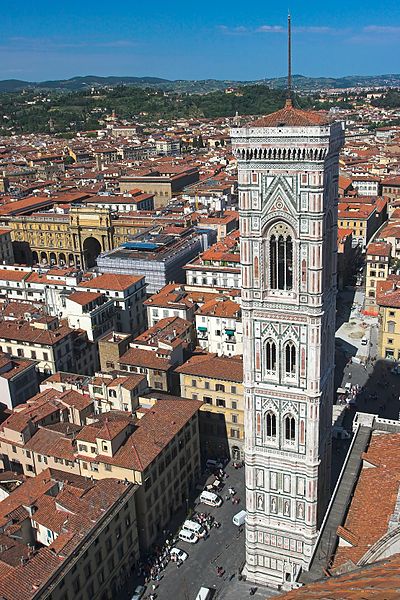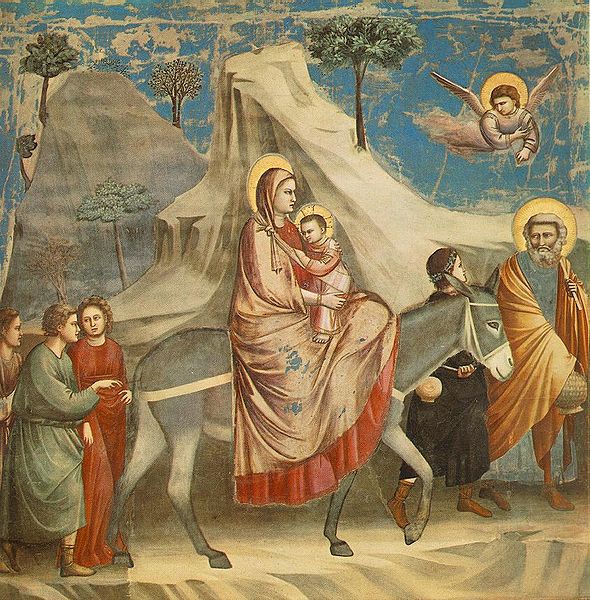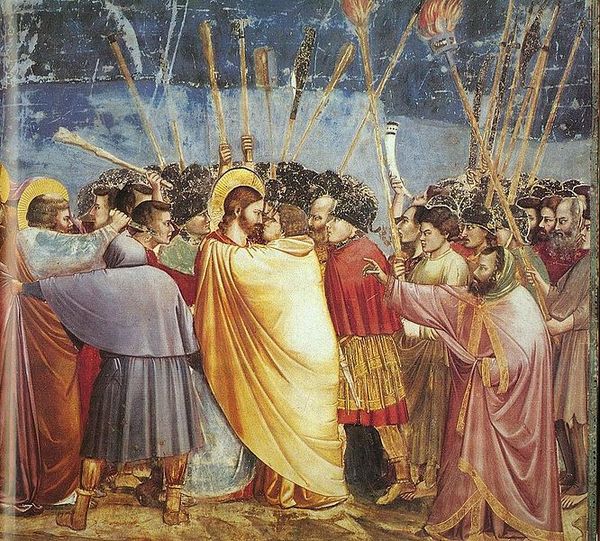Giotto
Giotto, whose real name was Giotto di Bondone, was the son of a peasant. He lived in the country outside of Florence, and as a child worked to help maintain the family. His working hours were occupied with the care of a herd of goats, the property of his family. Giotto was a born artist, and his lively charges supplied him with interesting subjects for practice in drawing. Like the primitive artists of the ancient world, the young goat herd employed a rock as a canvas on which to sketch the outlines of his models, and mother earth served the purpose of a background and easel.
Giotto's parents were in humble circumstances, and it seemed that their talented son would have to content himself with sketching, for they were too poor to pay for his instruction in the art of painting. This did not discourage the young artist, and he continued to sketch his beloved charges whenever he had an idle moment, and his industry was finally rewarded, for it proved to be the turning point in his life. This is how it came about.
One day, while he was busily engaged in sketching one of his many charges, a man came up behind him, but Giotto was so interested in his subject that he did not notice the stranger's approach. Unaware of his presence, the boy continued his work while his one man audience looked on. The stranger, who was none other than the great Cimabue himself, recognized in the little peasant boy the making of a great artist, and satisfied that he had discovered one destined to become a shining light in the world of painting, the artist talked to the boy and asked him if he would like to go to Florence and learn to paint. Giotto, who no doubt considered his questioner a fairy prince in disguise, readily consented, and Cimabue then went to see his father who agreed to let him go. A new life was thus opened to the little peasant boy, whose world up to that time had not extended beyond the limits of the hills and pastures where his charges grazed, for when Cimabue returned to Florence, Giotto accompanied him, and he began to study painting under his tutelage. Giotto proved an apt pupil and made rapid advances in his art. In fact in a short time, he surpassed the great Cimabue himself.
Giotto painted pictures in the principal cities of Italy, and examples of his best work may be seen in the Church of St. Francis of Assisi and St. Peter's in Rome.
His mosaic of the Navicella in St. Peter's, designed by him in 1298, has undergone so many changes and has been repaired and restored so many times that today only the composition can be credited to Giotti. The work as it appears at present is not the original Mosaic, but the product of hands other than the designers.
In Giotto's declining years he was given a commission to design a campenile or bell tower for the city of Florence, but he died before it was completed. His ideas, however, were carried out, and this beautiful bell tower stands in Florence today a fitting monument to a great artist.

Giotto's Bell Tower in Florence, Italy
Giotto, we are told, was a homely little man, but he has given the world unsurpassed beauty that has endured for centuries. In the Lower church of Assisi he painted the ceiling after first dividing it into four compartments. In three of these he painted subjects representing the vows of the Franciscan Order - (Poverty, Chastity and Obedience), while the fourth compartment was occupied by his conception of the "Glorification of St. Francis."
In the Arena Chapel, Padua, others of his paintings may be seen, prominent among them being "The Flight into Egypt" and "Judas Betraying Christ".

The Flight into Egypt, 1304-1306
Arena Chapel in Padua, Italy
Giotto (1266-1337)
"The Navicella" is a mosaic that may be seen in the portico of St. Peter's Church at Rome. It is a representation of a ship in which eleven of the apostles are seated while the waves beat against it. On the right Christ is seen raising St. Peter from the angry sea. To the left of the boat a man sits calmly fishing. The ship symbolizes the Church; the stormy sea, the world which cannot destroy the ship because Christ is with her. The calm fisherman is a symbol of the "hope of the believer."
A short time after the birth of Christ, the "Three Wise Men" from the East arrived in Jerusalem in quest of the new-born King of the Jews. They said they had seen His star in the East and had come to adore Him. When King Herod heard this he greatly worried, and calling his chief priests and doctors of the law, he asked them where Christ should be born, and they replied in Bethlehem.
When Herod heard this, he called the three kings to come and tell him so that he might also go and adore Him the new-born King, and so they returned to their own country by another route. When Herod learned what they had done he became enraged, and ordered all the male children in Bethlehem of two years and under to be slain.
But an Angel appeared to Joseph in his sleep, and bade him take the Child and its mother and flee into Egypt, and to remain in that country until told to return. Joseph immediately arose, and taking the Child and Its Mother went into Egypt.
When Jesus had finished His prayer in the garden of Gethsemani, coming to His disciples, He said. "Arise, let us go; he that shall betray Me is at hand."
And while He was speaking to His apostles, a multitude of people, armed with swords, clubs and torches, entered the garden. At their head walked Judas Iscariot, who approached Jesus and said "Hail Rabbi". Then he kissed him.

Kiss of Judas, 1304-1306
Arena Chapel in Padua, Italy
Giotto (1266-1337)
Giotto died in 1337. His followers, who are called Giottoesques, tried to imitate his works, but their productions could not compare with Giotto's, and art in Italy declined for about three quarters of a century.
The next great painter was Fra Angelico, born in 1387, just fifty years after the death of Giotto.
| Page 6 | Beginning of Book | Page 8 |